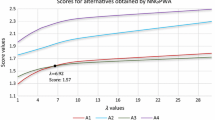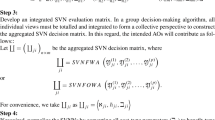Abstract
This paper develops a method for solving the multiple attribute decision-making problems with the single-valued neutrosophic information or interval neutrosophic information. We first propose two discrimination functions referred to as score function and accuracy function for ranking the neutrosophic numbers. An optimization model to determine the attribute weights that are partly known is established based on the maximizing deviation method. For the special situations where the information about attribute weights is completely unknown, we propose another optimization model. A practical and useful formula which can be used to determine the attribute weights is obtained by solving a proposed nonlinear optimization problem. To aggregate the neutrosophic information corresponding to each alternative, we utilize the neutrosophic weighted averaging operators which are the single-valued neutrosophic weighted averaging operator and the interval neutrosophic weighted averaging operator. Thus, we can determine the order of alternatives and choose the most desirable one(s) based on the score function and accuracy function. Finally, some illustrative examples are presented to verify the proposed approach and to present its effectiveness and practicality.
Similar content being viewed by others

References
Atanassov K (1986) Intuitionistic fuzzy sets. Fuzzy Sets Syst 20:87–96
Broumi S, Smarandache F (2014) Single valued neutrosophic trapezoid linguistic aggregation operators based multi-attribute decision making. Bull Pure Appl Sci Math Stat 33(2):135–155
Broumi S, Smarandache F (2015) New operations on interval neutrosophic sets. J New Theory 1:24–37
Broumi S, Ye J, Smarandache F (2015) An extended TOPSIS method for multiple attribute decision making based on interval neutrosophic uncertain linguistic variables. Neutrosophic Sets Syst 8:23–32
Li DF (2005) Multiattribute decision making models and methods using intuitionistic fuzzy sets. J Comput Syst Sci 70:73–85
Liu P, Shi L (2015) The generalized hybrid weighted average operator based on interval neutrosophic hesitant set and its application to multiple attribute decision making. Neural Comput Appl 26(2):457–471
Liu P, Wang Y (2014) Multiple attribute decision-making method based on single-valued neutrosophic normalized weighted Bonferroni mean. Neural Comput Appl 25(7–8):2001–2010
Liu P, Chu Y, Li Y, Chen Y (2014) Some generalized neutrosophic number Hamacher aggregation operators and their application to group decision making. Int J Fuzzy Syst 16(2):242–255
Majumdar P, Samanta SK (2014) On similarity and entropy of neutrosophic sets. J Intell Fuzzy Syst 26(3):1245–1252
Nayagam VLG, Muralikrishnan S, Sivaraman G (2011) Multi-criteria decision-making method based on interval-valued intuitionistic fuzzy sets. Expert Syst Appl 38(3):1464–1467
Peng JJ, Wang J, Zhang HY, Chen XH (2014) An outranking approach for multi-criteria decision-making problems with simplified neutrosophic sets. Appl Soft Comput 25:336–346
Peng JJ, Wang JQ, Wang J, Zhang HY, Chen XH (2015) Simplified neutrosophic sets and their applications in multi-criteria group decision-making problems. Int J Syst Sci. doi:10.1080/00207721.2014.994050,201
Peng JJ, Wang JQ, Wang J, Wu XH, Chen XH (2015) The fuzzy cross-entropy for intuitionistic hesitant fuzzy sets and its application in multi-criteria decision-making. Int J Syst Sci. doi:10.1080/00207721.2014.993744
Peng JJ, Wang JQ, Wang J, Wu XH, Chen XH (2015) Multi-valued neutrosophic sets and power aggregation operators with their applications in multi-criteria group decision-making problems. Int J Comput Intell Syst 8(4):345–363
Sahin R, Kucuk A (2014) Subsethood measure for single valued neutrosophic sets. J Intell Fuzzy Syst. doi:10.3233/IFS-141304
Smarandache F (1998) Neutrosophy. Neutrosophic probability, set, and logic. Amer. Res. Press, Rehoboth, p 105
Tian ZP Wang J Zhang HY Chen XH, Wang JQ (2015) Simplified neutrosophic linguistic normalized weighted Bonferroni mean operator and its application to multi-criteria decision-making problems. FILOMAT
Wang YM (1998) Using the method of maximizing deviations to make decision for multi-indices. Syst Eng Electron 7:24–26
Wang H, Smarandache F, Zhang YQ, Sunderraman R (2005) Interval neutrosophic sets and logic: theory and applications in computing. Hexis, Arizona
Wang H, Smarandache F, Zhang YQ, Sunderraman R (2010) Single valued neutrosophic sets. Multispace Multistruct 4:410–413
Wang J, Nie R, Zhang H, Chen X (2013) Intuitionistic fuzzy multi-criteria decision-making method based on evidential reasoning. Appl Soft Comput 13(4):1823–1831
Wang J, Nie R, Zhang H, Chen X (2013) New operators on triangular intuitionistic fuzzy numbers and their applications in system fault analysis. Inf Sci 251:79–95
Wang J, Zhou P, Li KJ, Zhang HY, Chen XH (2014) Multi-criteria decision-making method based on normal intuitionistic fuzzy-induced generalized aggregation operator. TOP 22:1103–1122
Wei G, Zhao X, Lin R, Wang H (2013) Uncertain linguistic Bonferroni mean operators and their application to multiple attribute decision making. Appl Math Model 37(7):5277–5285
Xu ZS, Xia MM (2012) Hesitant fuzzy entropy measures and their use in multi-attribute decision making. Int J Intell Syst 27:799–822
Ye J (2013) Multicriteria decision-making method using the correlation coefficient under single-valued neutrosophic environment. Int J Gen Syst 42(4):386–394
Ye J (2014) Similarity measures between interval neutrosophic sets and their applications in Multi-criteria decision-making. J Intell Fuzzy Syst 26:165–172
Ye J (2014) Single valued neutrosophic cross-entropy for multi-criteria decision making problems. Appl Math Model 38(3):1170–1175
Ye J (2014) Trapezoidal neutrosophic set and its application to multiple attribute decision making. Neural Comput Appl. doi:10.1007/s00521-014-1787-6
Ye J (2014) Some aggregation operators of interval neutrosophic linguistic numbers for multiple attribute decision making. J Intell Fuzzy Syst 27:2231–2241
Ye J (2014) A multicriteria decision-making method using aggregation operators for simplified neutrosophic sets. J Intell Fuzzy Syst 26(5):2459–2466
Zadeh LA (1965) Fuzzy sets. Inf Control 8:338–353
Zhang HY, Wang JQ, Chen XH (2014) Interval neutrosophic sets and their application in multicriteria decision making problems. Scic World J. doi:10.1155/2014/645953
Zhang HY, Wang J, Chen XH (2015) An outranking approach for multi-criteria decision-making problems with interval-valued neutrosophic sets. Neural Comput Appl. doi:10.1007/s00521-015-1882-3
Acknowledgments
This paper is supported by the National Natural Science Foundation of China (Nos. 71471172 and 71271124), and the authors also would like to express appreciation to the anonymous reviewers and Editors for their very helpful comments that improved the paper.
Author information
Authors and Affiliations
Corresponding authors
Rights and permissions
About this article
Cite this article
Şahin, R., Liu, P. Maximizing deviation method for neutrosophic multiple attribute decision making with incomplete weight information. Neural Comput & Applic 27, 2017–2029 (2016). https://doi.org/10.1007/s00521-015-1995-8
Received:
Accepted:
Published:
Issue Date:
DOI: https://doi.org/10.1007/s00521-015-1995-8



